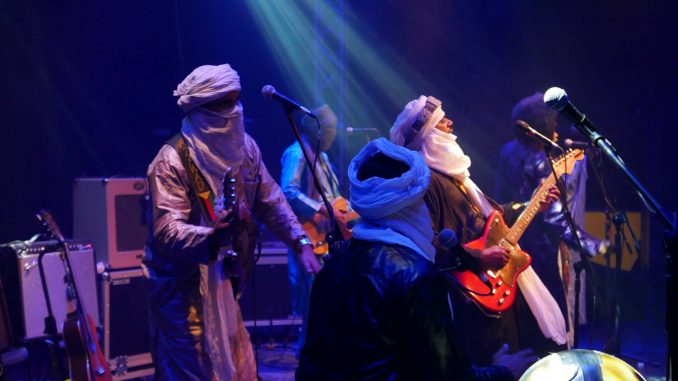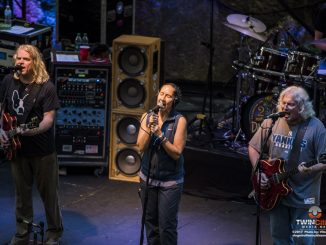
Photo Credit: Tinawiren Facebook
As I made my way toward the Cedar Cultural Center to see Grammy Award winning Tinawiren, I realized it had been awhile since I’d attended a show with an act that I’d never heard on the radio or in person. I felt a bit ashamed for my role in the travesty that sees phenomenal touring acts play to small crowd while one hit wonders make millions of dollars. When was the last time I (or you) had come out to a show with no established background? When was the last time we showed up to support an unfamiliar artist for the artists’ sake rather than our own consumer self interest? When was the last time any of us called a friend the morning after and said: “I just had the most unexpected, mind blowing experience with this band last night!”?
Asked another way: at Christmas would you rather open a package that has just what you asked for or one that is completely original? Let’s be honest here. There’s a reason chain restaurants and fast food joints dot the landscape. It isn’t about saving time. It’s about being more inclined to take something familiar rather than risk the new.
The long line that stretched up the sidewalk nearly to Riverside was an immediate relief. Let’s give credit where credit is due. The Cedar Cultural Center is the only venue in town that has the credibility to be able to bring in acts from around the globe that few locals know and manage to pack the joint. It’s something they’ve done for nearly 30 years and Tuesday’s show was simply one more example of how well they curate.
Astralblak was just firing up as I walked in. Formerly Zuluzuluu, this local quintet is an act I had not seen in just over a year. Those previous times had all been in some kind of festival setting where they were in and out quickly. Their spot in those line ups seemed a bit awkward. Frankly, I was questioning their inclusion as opener on this bill. I had never really gotten a sense of who they were and what specifically they were trying to create. Last night I got it. They were exceptional.
Maybe it was a setting that was really perfect for them. Maybe it was that they have evolved and the longer set gave them the opportunity to fully get in the groove. Maybe it was the quality of the music from a soon to be released new album. Bottom line is that none of that mattered. They showed major chops and creativity as they spanned the gamut from hip hop to funk to psychedelia to spoken word. For the first time I truly appreciated the Prince influence and the beauty of being willing to spin on a dime and head off in another cosmic direction. Everything they did was imbued with a joy and a framework of peace.
This light bulb went off in my head about midway through Astralblak’s set. This was the perfect complement to Tinawiren. Not because they were musically similar but because they represented the natural continuation, the opposite end of the same branch as the headliner. Whereas Tinawiren was going to dish out traditional Taureg music, Astralblak relied on electronics and technology to make a different type of what clearly remains an African influenced communal music. It struck me that in both cases musicians simply picked up the instrument or technology available to them and found a way to creatively put it together to create a cohesive whole that communicated well with a participating audience.
As Tinawiren took the stage, the contrast between African and African-American was sharp. Where the former was clad in the de rigueur stage black, the latter arrived in agbada, kaftan and djellaba. North Africa literally blew into the Cedar like a scirocco.
I’m not sure exactly what I was expecting. As a fan of Bombino for a number of years I was leaning in that direction. It became immediately clear that this band was going to be as traditional as Bombino was Americanized. There is little question that the influence of The Black Keys’ Dan Auerbach on his sound helped make him more accessible; perhaps because the structure hewed more closely to a recognizable blues construction. Tinawiren had exactly one moment in the entire set that seemed American influenced, a late funky bass solo. The rest of the show was unfiltered and unchanged from generations before them.
So how best to explain what they do? First, despite the Fender and Gibson guitars on stage the basic structure sounded just like it could have easily been done with traditional African instruments employed around a large desert bonfire. The sounds they coax from the familiar instruments was fascinating. No picks employed. Fingers and nails are used in a manner which is culturally so different from what how those instruments are played in the West. No strummed chords. Bass line played with the thumb while fingers picked melody lines using both the front and back of the nail. This was mastery of stringed instruments that had everything to do with being handed down and self taught. This impression was at the core of everything the band did. Simple, traditional and yet raised to high art.
Tinawiren is first and foremost a jam band. Everything is built around the African drum(s). From where I was perched I initially thought the drummer was using a drum machine. However, it was a simple conga and gourd. Amazing that one musician could replicate most of the sounds of a full drum kit with his hands. By simply striking a specific spot to produce a specific sound.
Bass is simple and repetitive. Mesmerizing. Together, they create a heartbeat. That heartbeat connects directly to the other players and the audience. Everybody shuffles and sways. The guitar work is liquid and chiming. It weaves through a series of slowly evolving melody lines that build and swell before coming back to ground zero. Unlike Western music where guitar is king, it provides layers and intricacies.
African music, in fact almost any type of indigenous music, is built around the most human of instruments. The voice. Tinawiren features a pair of lead vocalists who alternated their time on stage. At times all 6 members of the band were singing simultaneously. This was not sophisticated harmony. This was simply communal. The depth came from the fact that each singer had his own voice. So it was like singing in church or everyone singing around the fire. Albeit in this case, I never understood a single word. None of the band spoke English. Only a few words between songs and the regularly asked question: “Uz good?” The Cedar audience was always quick to confirm it was.
Tinawiren has been billed as true Rock n Roll Rebels. Musically, I don’t quite understand that description. On the one hand I get the fact that the band members truly are political rebels in their own homeland. There have been musical hiatuses when band members were in the mountains fighting against encroaching war lords and Jihadists. There have been periods when band members were imprisoned because they have been outspoken or simply because of what they do. Playing live music in some cultures is in and of itself deemed immoral. But applying the term rock n roll implies an approach that’s recognizably blues or American. Not even close here. The only connection is in the form of the Fenders and Gibsons. That, I expect, is simply because they are amplified; a prerequisite to playing for a large audience.
I expected to hear songs of rebellion, laced with anger. Perhaps that was in the French or African lyrics I could not understand. Musically, things never got too hot or too cold. The tunes just seemed to want to pull you in, to participate. The songs all seemed to be stories. The teller speaks and the people respond. At times a sense of longing and loss? Absolutely. But fiery or angry, no. As previously mentioned, Tinawiren just seems remarkably communal. From a time and place where stories are handed down rather than made a part of a written history.
I’m a big fan of visual performance. Shows in which the artists are too slick or simply play their music seems two dimensional to me. I’d just as soon listen to the record in the comfort of my own home. I much prefer something coming visually from the stage where the band is finding joy in the creation process and is able to engage the audience in that joy. It occurred to me on a number of occasions how naturally Tinawiren does this. No lights, no stage show, per se. Just natural rhythm, movement and musical interaction. It’s all about the groove with these guys. It’s a place where the Arab world meets Africa. The flowing robes and flowing dance steps immediately reminded me of the snake charmer in the bazaar. They are hypnotic, trance like, exotic.
As the band wound up a very satisfying evening I pondered what my ears and eyes were telling me. At a time in the world when the West fights what amounts to a Cold War against much of the Arab world; where the Horn of Africa simmers as flash point for conflict, these are individuals from that part of the world who picked up a guitar rather than a gun. They were unabashedly authentic and comfortable performing in their own style and idiom. Any visual prejudices are swept aside as music connects radically different cultures.
As a music community it is important to continue to support the Cedar. They provide a critical artistic bridge to a wider world. They do it better than anybody else in the country. The next time an artist or band comes to town with whom you are unfamiliar, take an extra minute to read about them. Take a chance. It’s a two way street. No doubt it’s gratifying for bands like Tinawiren to play a packed and appreciative club. There is also little doubt that opening that unexpected treasure under the tree is worth ten that you were expecting.



